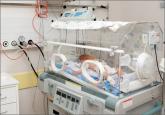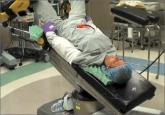From the Editor

Transfer to the hospital for women planning a home birth: A high-risk obstetrics problem
Do you have a written clinical guideline for pregnant women planning a home birth who are transferred to your hospital?

Notable judgments and settlements
Blue, floppy, apneic baby: $3.25M settlement
When a mother went to the hospital in labor, the fetal heart-rate monitor showed a baseline of 140–150 beats per minute (bpm). When the monitor was reapplied 3.5 hours later, the baseline heart rate had risen to 160–165 bpm and demonstrated mild but persistent decelerations. Three hours later, the mother was found to have a fever of 100.5°F; antibiotics were ordered. When persistent fetal tachycardia became evident, the mother’s membranes were artificially ruptured. Thick meconium was noted. After a direct fetal lead was applied, moderate fetal distress was apparent. The mother’s fever rose and the fetus’ late decelerations and tachycardia continued. A cesarean delivery was ordered 12 hours after the mother’s arrival.
The baby was born 45 minutes later. She was blue, floppy, and apneic, with a heart rate of 50–60 bpm. Her Apgar scores were 1, 7, and 9, at 1, 5, and 10 minutes, respectively. She was found to have hypoxic ischemic encephalopathy. The child has right-sided weakness and other cognitive impairments including speech and language delays.
PARENTS’ CLAIM The attending family physician, a second-year resident, and the attending nurse were negligent in the care of the mother during labor and delivery. Cesarean delivery should have been performed earlier when the mother developed a fever and the fetus’ tachycardia was persistent.
defendants’ DEFENSE The case was settled during trial.
VERDICT A $3.25 million Massachusetts settlement was reached.
_________________
MRSA after breast augmentation: $1M verdict
A plastic surgeon performed bilateral breast augmentation surgery on a 31-year-old woman with the help of an assistant. The operation was performed at the physician’s office. The patient was given lidocaine, diazepam (Valium), and acetaminophen and oxycodone (Percocet) as anesthetics. General anesthesia was not administered. Two 4-inch incisions were created to insert the implants.
A month later, the patient went to the emergency department (ED) reporting chest pain. She was found to have methicillin-resistant Staphylococcus aureus (MRSA) infection. She was hospitalized for 6 days.
A month later, she returned to the ED with continuing symptoms. Another surgeon removed the breast implants. A peripherally inserted central catheter (PICC) line was placed for administration of antibiotics to treat the ongoing infection. After several months, she was infection-free.
PATIENT’S CLAIM The initial breast augmentation surgery should have been conducted under sterile conditions in a surgical center under general anesthesia. The assistant was not a licensed nurse or surgical technician.
DEFENDANTS’ DEFENSE The infection is a known risk of the procedure. Sulfamethoxazole/trimethoprim (Bactrim) had been prescribed. The plastic surgeon was not given the chance to treat the infection, as the patient went to the ED instead of calling him and changed physicians.
VERDICT A $1 million Georgia verdict was returned.
_________________
Respiratory arrest after pain meds administered
A 53-year-old woman underwent gynecologic surgery. In the recovery room, a Certified Registered Nurse Anesthetist (CRNA) administered intravenous hydromorphone hydrochloride (Dilaudid HP) 2 mg for pain management. The patient went into respiratory arrest. She was resuscitated, but experienced an hypoxic brain injury. She is now legally blind and has memory deficits and confusion.
PATIENT’S CLAIM The CRNA gave an excessive dose of hydromorphone to the patient.
DEFENDANTS’ DEFENSE The dosage was appropriate. Respiratory arrest is a risk of the surgery that can occur without negligence.
VERDICT A Tennessee defense verdict was returned.
_________________
$2.97M verdict after mother and baby die from urosepsis
A 27-year-old woman was pregnant with her second child. The ObGyn had delivered her first child and provided prenatal care once again. Early in the otherwise uncomplicated second pregnancy, the mother developed pyelonephritis.
At 19 weeks’ gestation, she went to the ED with abdominal pain. The hospital nurses told her ObGyn they thought she had a urinary tract infection. He concurred without seeing her, ordered antibiotics and pain medication, and she was discharged.
When her condition worsened the next day, she returned to the ED, where she was found to have urosepsis. A urogynecologist took over her care and performed emergency surgery. The fetus died during surgery. The mother went into cardiac arrest as surgery ended. She was resuscitated but suffered significant brain damage; she died 4 days later when life support was removed.
ESTATE’S CLAIM The ObGyn was negligent in not coming to the hospital to examine the patient during her initial ED visit, knowing her history of pyelonephritis. The patient should not have been discharged; intravenous administration of antibiotics would have allowed both mother and fetus to survive.
DEFENDANTS’ DEFENSE Admission at the first ED visit was not warranted. A 19-week-old fetus is not viable.

Do you have a written clinical guideline for pregnant women planning a home birth who are transferred to your hospital?

Notable judgments and settlements
New guidance this year: We need to be more vigilant for group B strep and influenza in pregnancy and give prophylactic antimicrobials before the...

Appropriate patient positioning for laparoscopic and robotic surgery can help prevent postoperative neuropathies. This case-based video describes...
Should endometriomas be simply drained? Drained and coagulated? Or resected? Should implants be resected, or ablated? And is surgery a concluding...
